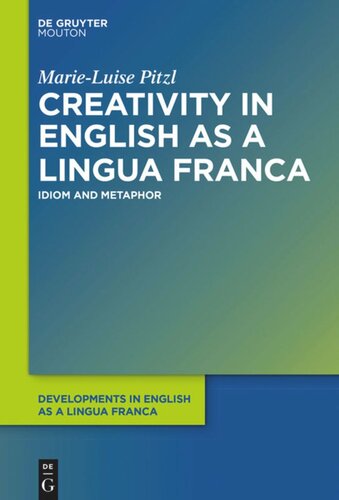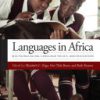Creativity in English as a Lingua Franca Idiom and Metaphor 1st Edition by Marie Luise Pitzl ISBN 9781501510038 1501510037
$50.00 Original price was: $50.00.$25.00Current price is: $25.00.
Creativity in English as a Lingua Franca Idiom and Metaphor 1st Edition by Marie Luise Pitzl – Ebook PDF Instant Download/Delivery: 9781501510038 ,1501510037
Full download Creativity in English as a Lingua Franca Idiom and Metaphor 1st Edition after payment

Product details:
ISBN 10: 1501510037
ISBN 13: 9781501510038
Author: Marie Luise Pitzl
Creativity in English as a Lingua Franca Idiom and Metaphor 1st Edition Table of contents:
1 English as a lingua franca: Why creativity?
1.1 Characterizing ELF: Initial remarks
1.1.1 Early definitions and the role of the *native speaker
1.1.2 Multilingual ELF users
1.1.3 ELF and the variety issue
1.2 Engaging with ELF: Facing a paradox
1.2.1 ELF is like other *languages: Principles of variation
1.2.2 ELF is unlike other *languages: External sociolinguistic conditions
1.2.2.1 Communities of Practice (CoPs)
1.2.2.2 Transient International Groups (TIGs)
1.3 Creativity in language use
1.3.1 Approaches to creativity in linguistics
1.3.2 Creativity and norms
1.3.3 Creativity as potential change: A systems view
1.4 Creativity in ELF: Norm-following and norm-transcending
1.5 Summary
2 Creativity, idiom and metaphor
2.1 Idioms and territoriality
2.2 Idioms and idiomaticity
2.2.1 Idiomatic? Formulaic? Phraseological? Coming to terms with terminology
2.2.2 Old (labelling) habits die hard: Idiomatic = nativelike?
2.2.3 Idioms vs. idiomatizing: Product and process
2.2.4 Conventional variability
2.3 Metaphor and metaphoricity
2.3.1 Cognitive aspects: Conceptual Metaphor Theory and ELF
2.3.2 Psycholinguistic aspects: Linguistic metaphor and metaphoric potential
2.3.3 Semantic aspects: Degrees of metaphoricity
2.3.4 Dimensions of metaphor analysis in spoken language
2.4 An ELF approach to creativity at the level of idioms
2.4.1 The chicken or the egg? The diachronic dimension of idiom and metaphor
2.4.2 Intrinsic creativity and the myth of non-compositionality
2.4.3 Idiom decomposition and figurative compositionality
2.4.4 The re-metaphorization of idioms: Metaphor as a shared resource in ELF
2.5 Summary
3 Describing ELF: Analyzing VOICE
3.1 The data: The Vienna-Oxford International Corpus of English
3.1.1 Quantitative aspects: Design and structure
3.1.2 Qualitative aspects: The ethnographic dimension
3.1.3 Corpus texts: Properties of transcripts
3.2 Research methodology: Identifying instances of linguistic creativity
3.2.1 Annotating creative idioms
3.2.2 Annotating metaphors and judging metaphoricity
3.3 Analyzing ELF interactions: Questions of interpretation
3.3.1 Forms and functions
3.3.2 Corpus evidence, contextual information and insider knowledge
3.3.3 Judging understanding and communicative effect(ivenes)s
3.4 Summary
4 Creative idioms in ELF interactions: Exploring forms
4.1 Types of idiom variation: Lexical substitution
4.1.1 Semantic relationships and fields
4.1.1.1 Semantically related words
4.1.1.2 Hyponyms and superordinate terms
4.1.1.3 Terms of embodiment
4.1.1.4 Abstract words and shift in metaphorical resonance
4.1.2 Alternative interpretations and theoretical implications
4.1.2.1 Identifying corresponding idiom(s)
4.1.2.2 Creative idiom or overt metaphor?
4.1.2.3 Lexical substitution as indicator of metaphor processing?
4.2 Types of idiom variation: Syntactic and morphosyntactic variation
4.2.1 Formal characteristics of syntactic variation
4.2.2 Formal characteristics of morphosyntactic variation
4.2.2.1 Pluralization
4.2.2.2 Flexible use of determiners
4.2.2.3 Prepositional variation
4.2.3 Creative or conventional use? – Case studies with BNC and COCA
4.3 Summary
5 Functions of creative idioms and metaphors in ELF interactions
5.1 Humor and mitigation
5.2 Talking about abstract concepts, increasing explicitness and projecting stance
5.3 Re-creating clichés for rapport and comity
5.4 Solidarity and shared *non-nativeness
5.5 Emphasizing, summarizing and indicating metaphor awareness
5.6 The myth of miscommunication
5.7 Summary: Ideational and interpersonal functions
6 Metaphorical creativity in ELF interactions: Discovering patterns and systematicities
6.1 Overt metaphors and linguistic creativity
6.2 Metaphorical patterns and local systematicities
6.3 Metaphoricity beyond idiomaticity: Embodied experience
6.3.1 Feet, toes, shoulders and hands
6.3.2 Faces and eyes
6.3.3 Head, brain and mind
6.3.4 What lies at heart: A case study of metaphorical creativity
6.4 Summary
7 The multilingual dimension of metaphorical creativity
7.1 Individual multilingual repertoires and multilingual resource pools in ELF interactions
7.1.1 Language contact via ELF
7.1.2 ELF as transient language contact: IMR and MRP
7.2 Multilingual idiom and multilingual metaphor resource pool in ELF interactions
7.2.1 ‘Waking up dogs’: Metaphors with corresponding *English and other *language idioms
7.2.2 Borrowing images: Non-*English idioms and the metaphor-MRP
7.3 Idioms as displays of multilingual identity
7.3.1 Shared images and metalinguistic comments
7.3.2 Cultural stereotypes, humor and wordplay
7.4 Non-*English idioms and code-switching in ELF interactions
7.5 Summary
8 Implications of metaphorical creativity
8.1 Key findings revisited
8.1.1 Forms and patterns of creative idioms and metaphors in ELF
8.1.2 Functions of creative idioms and metaphors in ELF interactions
8.2 Theoretical implications
8.2.1 Re-metaphorization, metaphor clines and metaphor awareness
8.2.2 Creativity, convention, intention and awareness
8.2.3 Expanding methodologies for the study of ELF: Context(s), groups and development
8.3 Pedagogical implications
8.3.1 Suggestions for language educators
8.3.2 Starting somewhere …
Appendix
References
Index
People also search for Creativity in English as a Lingua Franca Idiom and Metaphor 1st Edition:
creativity in english as a lingua franca idiom and metaphor
creativity in linguistics
creativity metaphors
creativity metaphor examples
Tags: Marie Luise Pitzl, English, Creativity, Lingua Franca, Metaphor
You may also like…
Uncategorized
Education as Jazz Interdisciplinary Sketches on a New Metaphor 1st Edition Marina Santi
Reference - School Guides & Test Preparation
Linguistics - Sociolinguistics
Linguistics - Linguistics
Interpersonal Positioning in English As a Lingua Franca Interactions 1st Edition Svitlana Klötzl
Uncategorized
Metaphor in Psychotherapy A descriptive and prescriptive analysis 1st Edition Dennis Tay
Uncategorized
The Lingua Franca Contact Induced Language Change in the Mediterranean 1st Edition Natalie Operstein











